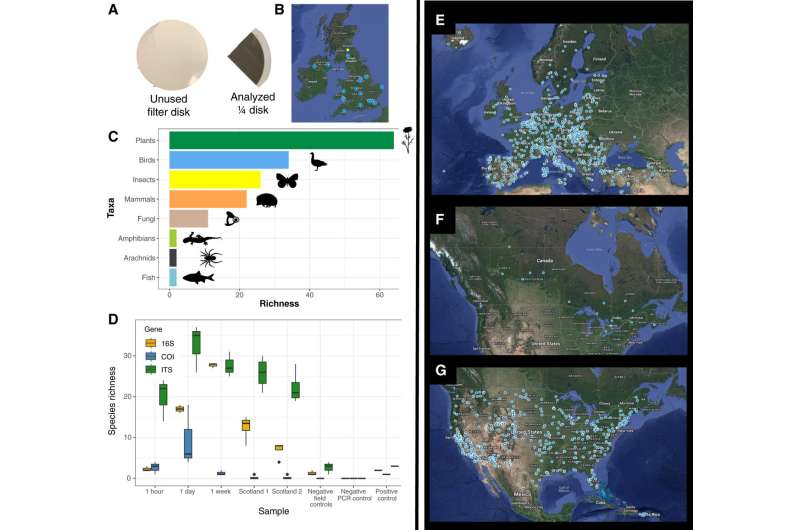This article has been reviewed according to Science X's editorial process and policies. Editors have highlighted the following attributes while ensuring the content's credibility:
fact-checked
peer-reviewed publication
trusted source
proofread
Scientists discover air quality monitoring stations are collecting urgently needed biodiversity data

The accelerating loss of biodiversity and increasing rate of species extinction is a major threat to ecosystems around the globe. And yet, quantifying those losses at a large scale hasn't been possible, in large part due to a lack of the required infrastructure. But a new study reported in the journal Current Biology on June 5 shows that a major source for such information already exists in the form of environmental DNA (eDNA), which has been inadvertently collected in filters by thousands of ambient air quality monitoring stations in countries around the world for decades.
"One of the biggest challenges in biodiversity is monitoring at landscape scales—and our data suggest this could be addressed using the already existing networks of air quality monitoring stations, which are regulated by many public and private operators," says Elizabeth Clare of York University Toronto, Canada. "These networks have existed for decades, but we have not really considered the ecological value of the samples they collect."
"Existing and established air quality networks are potentially a huge untapped source of biodiversity data," added Andrew Brown, National Physical Laboratory (NPL), Teddington, UK. "These networks continually sample particulate matter and we now have the ability to make use of this in a whole new way."
While the air quality monitoring stations have a long history, the approaches to capture and analyze eDNA out of the air were developed only recently. Two earlier studies, also in Current Biology (one by Clare and team), offered proof-of-concept evidence that it was possible to identify species in a zoo by sampling the air.
Study collaborator James Allerton, National Physical Laboratory (NPL), Teddington, UK, said it was after reading about those findings that he and his NPL colleagues began to consider whether filters used to collect air quality data might have value for collecting DNA and approached Littlefair and Clare.
In their new study, researchers including Clare, Allerton, and Brown along with Nina Garrett, York University Toronto, and first author Joanne Littlefair, Queen Mary University of London, tested whether airborne eDNA containing information about the local plant, insect, and other animal life is captured on filters as a by-product of regularly operating air quality monitoring networks that are intended to monitor heavy metals and other pollutants in the atmosphere. After extracting and amplifying DNA from filters sampled at monitoring stations at two locations in the UK, they found an astonishing record of biodiversity trapped on the filters.
Their analyses recovered eDNA from more than 180 different plants, fungi, insects, mammals, birds, amphibians, and other groups. They report that the species list included many "charismatic species such as badgers, dormice, little owls, and smooth newts, species of special conservation interest such as hedgehogs and songbirds, trees including ash, linden, pine, willow, and oak, plants like yarrows, mallows, daisy, nettles, and grasses, arable crops such as wheat, soybean, and cabbage."
They also note that the filters had DNA from 34 species of birds. The data showed that longer sampling times captured an increased number of vertebrate species, presumably as more mammals and birds visited the area over time.
The researchers contend, based on their findings, that air quality monitoring networks have been gathering local biodiversity data in a standardized way and on continental scales routinely for many years but that "the ecological significance of these samples has gone unnoticed." In some places, samples are kept for decades, suggesting that existing samples capturing ecological data over time already exist. With only minor changes to current air quality monitoring protocols, the researchers say that these samples could be used for detailed monitoring of terrestrial biodiversity, relying entirely on a network that is already in operation.
"The most important finding, to my mind, is the demonstration that aerosol samplers typically used in national networks for ambient air quality monitoring can also collect eDNA," Allerton said. "One can infer that such networks—for all their years of operation and in other countries around the world—must have been inadvertently picking up eDNA from the very air we breathe."
"The potential of this cannot be overstated," Littlefair said. "It could be an absolute gamechanger for tracking and monitoring biodiversity. Almost every country has some kind of air pollution monitoring system or network, either government owned or private, and in many cases both. This could solve a global problem of how to measure biodiversity at a massive scale."
The team is now working to preserve as many samples as possible with eDNA in mind. While the samples have already been collected, they say it will take a global effort to take full advantage of the biodiversity information they contain.
More information: Elizabeth Clare, A vault of biodiversity data is concealed in plain sight, Current Biology (2023). DOI: 10.1016/j.cub.2023.04.036. www.cell.com/current-biology/f … 0960-9822(23)00515-8
Journal information: Current Biology
Provided by Cell Press

















